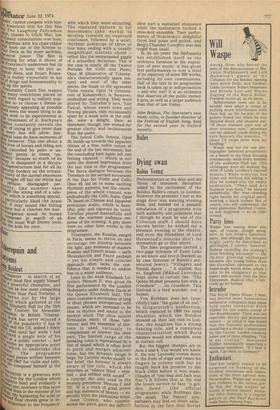IC
kilerepnin and lityens !Lridcut Ni31hPoser in search of an ,,ith`riee Must first supply himself 'ler„ a Powerful champion, and be few more compelling aei''Ilions than Paul Tortelier, a oorne out by the large :lice which gathered at the i:til : `,,r1 Elizabeth Hall for the 75th Fq1,44Y Concert for Alexander 1irr;relanin. In Britain TcherepSCh Work has never enjoyed a i rrk; ef the popularity it has n and the US; indeed I freely 4orh` that until last week I had i ,,Ntis'leard a single note of his fte at a public concert — and seeMs an appropriate point tqlithWhich to undertake this IS5.:..;r1• The programme Nin,s''sed pieces written between hi.r%."'thcl 1947 for violin and cello, Nriq '"e composer himself at the 1,7 liker,ePnin is a generous man 4,-,love for the London which ,Iff4lects him) and evidently a 21)44,1-11 one; nowhere is this more h. Liclill;•rit than in the manner of is v‘siai's* MY hankering for solid or N-Ilerl final chords grew in inoi,
Pr
-eortion to the frequency
with which they were occurring. The repeated pattern is for movements (and works) to develop towards an expected conclusion, followed by a quiet, rhythmic postscript of three or four bars, ending with a usually insignificant staccato chord — rather like the embarrassed giggle of a schoolboy declaimer. This is the case in nearly all the Twelve Preludes for Cello and Piano, Opus 38 (illustrative of Tcherepnin's characteristically spare texture) and most of the other pieces; the finale to the agreeable Violin Sonata, Opus 14 (reminiscent of Kabalevsky), is, however, unabashed and strong. They were played by Tortelier's son, Yan Pascal, whose sweet tone and flowing phrases, only occasionally upset by a weak note in the middle, were a delight. Here as elsewhere, though, one wished for greater clarity and Incisiveness from the piano.
The lyrical Cello Sonata, Opus 30, builds up towards the apparent climax of a fine, noble canon at the end of the last movement, but the concluding bars again left one feeling cheated 7 which is not quite the desired Impression from the last item in the programme! The fierce dialogue between the Torteliers in the second movement of the Duo for Violin and Cello, Opus 49, led on to some exciting rhythmic patterns, but the centrepiece of the whole concert was undoubtedly the Cello Suite, Opus 79, based on Chinese and Japanese pentatonic scales, which is beautiful, jolly and vigorous by turns. Tortelier played masterfully and drew the warmest audience response of the evening. A pity there were no other later works in the programme
Tcherepnin, the Russian emigre in Paris, seems to thrive on and encourage the kinship between the light, gay moments of modern Russian and French music — early Shostakovich and Faure perhaps — yet his simple and concise approach often lacks the confidence that is needed to endear him to a wider audience.
Later in the week Elisabeth Lutyens's 'Plenum II' was given its first performance by the London Sinfonietta under Andrew Davis at the Queen Elizabeth Hall. The piece contains a succession of long or short phrases Interspersed with pauses, which are intended to be akin in rhythm and sound to the spoken word. The oboe soloist formulates many of these 'sentences' and the ensemble of thirteen is used variously to complement or answer the oboe part. The limited range of the speaking voice is represented by a line of sound which is often level in pitch and merges adjacent tones, but the dynamic range is large, for Lutyens sticks closely to her brief: the listener is always aware of the title, which she describes as "silence filled — emptied — and refilled with sound" — a concept she also used in the recently-premiered 'Plenum I' and 'III'. 'II' is a work of great power and has moments of beauty — especially from the pianissimo brass.
Janet Craxton, who commissioned the piece, gave the difficti!t oboe part a sustained eloquence while the Sinfonietta formed a close-knit ensemble. Their performance of Stravinsky's delightful Octet had poise and polish, and Berg's Chamber Concerto was less turgid than usual. '
In its six years the Sinfonietta has established itself as the orchestra foremost in the exposition of new music: it has given first performances to over a third of its repertory of some 300 works, including its own commissions. Half of the text in its programme book is taken up in self-promotion — and why not? It is an orchestra that deserves all the public money it gets, as well as a larger audience than that of last Friday.
John Bridcut, The Spectator's new music critic, is founder-director of the Festival of English Song, held for the second year in Oxford recently.


































 Previous page
Previous page